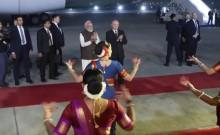Russia made history on 7, October, 2015 when it fired Kalibr supersonic cruise missiles into Syria from warships in the Caspian Sea - about 1,500km (930 miles) away on Islamic State (Isis) targets.
Four Russian naval ships fired 26 cruise missiles, hitting 11 Isis targets in Syria, Russian Defense Minister Sergei Shoigu told President Vladimir Putin, reported CNN.
The Russian cruise missiles flew over the Caucasus Mountains, Iran and Iraq before the precision attack hit targets in Isis held areas in the western portion of Syria.
According to a McClatchyDC report, the missile strikes covered almost 1,500km of precision flight, which is by far the longest range attack carried out by the Russian forces in modern history.
The long-range precision attack has left many military analysts shocked as many were unaware of Russia possessing such long range capability.
"We knew that both the Gepard frigate and Buyan corvettes were capable of launching land-attack cruise missiles, but the apparent range of the missiles has come as a surprise to us," Jeremy Binnie, a weapons expert for Janes IHS, the London-based defence think tank told McClatchyDC.
The Russian missile strike has come mere months after Bill Gertz of The Washington Free Beacon alerted that Russia has successfully tested its sea-launched cruise missile (SLCM), SS-N-30A, Kalibr.
It was reported that the cruise missile, which was tested in July was ready for deployment. The news of the Russian sea-launched cruise missile that could reach targets across Europe raised fears among many as the missile presented a threat similar to the SS-20 intermediate-range missiles, which the Soviets deployed in the late 1970s – early 1980s.
But they were eliminated under the 1987 INF Treaty.
"A cruise missile variant also is being developed that officials said appears to violate the 1987 Intermediate Range Nuclear Forces (INF) Treaty," Gertz had said.








![Sky is the limit: IndiGo is now tenth largest airline by capacity globally; growth indisputable [details]](https://data1.ibtimes.co.in/en/full/767455/sky-limit-indigo-now-tenth-largest-airline-by-capacity-globally-growth-indisputable-details.jpg?w=220&h=138)








![Sky is the limit: IndiGo is now tenth largest airline by capacity globally; growth indisputable [details]](https://data1.ibtimes.co.in/en/full/767455/sky-limit-indigo-now-tenth-largest-airline-by-capacity-globally-growth-indisputable-details.jpg?w=220&h=135)